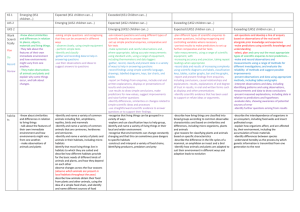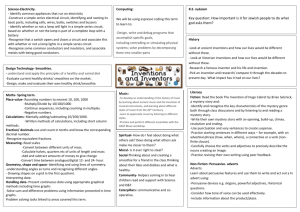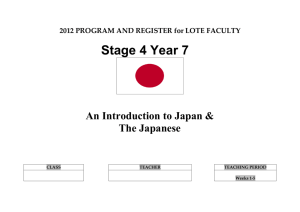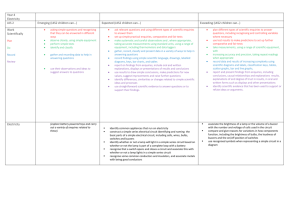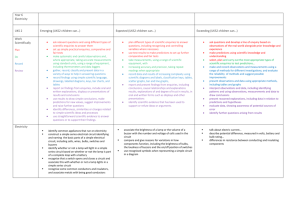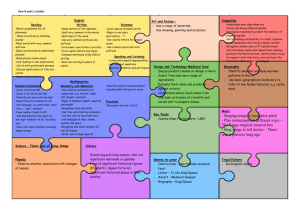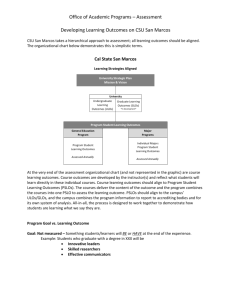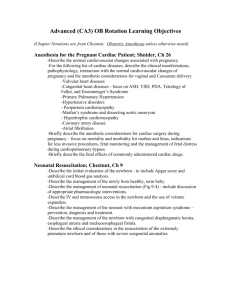Physics
advertisement
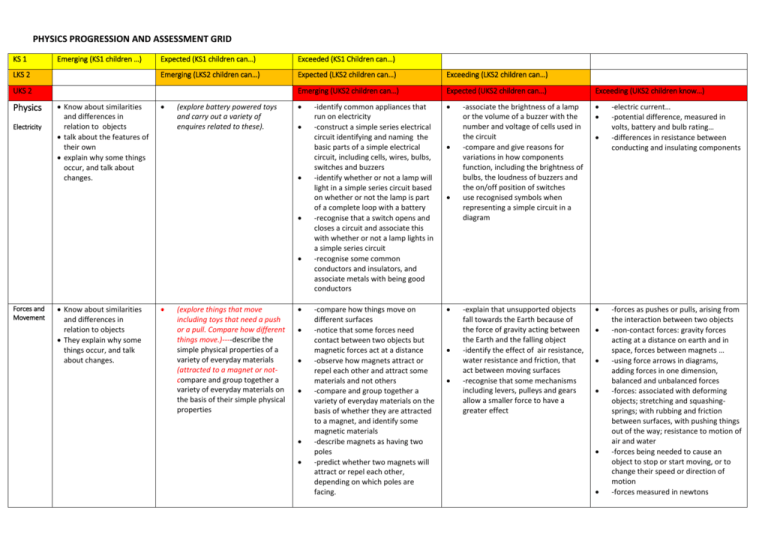
PHYSICS PROGRESSION AND ASSESSMENT GRID KS 1 Emerging (KS1 children …) LKS 2 Expected (KS1 children can…) Exceeded (KS1 Children can…) Emerging (LKS2 children can…) Expected (LKS2 children can…) Exceeding (LKS2 children can…) Emerging (UKS2 children can…) Expected (UKS2 children can…) Exceeding (UKS2 children know…) -identify common appliances that run on electricity -construct a simple series electrical circuit identifying and naming the basic parts of a simple electrical circuit, including cells, wires, bulbs, switches and buzzers -identify whether or not a lamp will light in a simple series circuit based on whether or not the lamp is part of a complete loop with a battery -recognise that a switch opens and closes a circuit and associate this with whether or not a lamp lights in a simple series circuit -recognise some common conductors and insulators, and associate metals with being good conductors -associate the brightness of a lamp or the volume of a buzzer with the number and voltage of cells used in the circuit -compare and give reasons for variations in how components function, including the brightness of bulbs, the loudness of buzzers and the on/off position of switches use recognised symbols when representing a simple circuit in a diagram -compare how things move on different surfaces -notice that some forces need contact between two objects but magnetic forces act at a distance -observe how magnets attract or repel each other and attract some materials and not others -compare and group together a variety of everyday materials on the basis of whether they are attracted to a magnet, and identify some magnetic materials -describe magnets as having two poles -predict whether two magnets will attract or repel each other, depending on which poles are facing. -explain that unsupported objects fall towards the Earth because of the force of gravity acting between the Earth and the falling object -identify the effect of air resistance, water resistance and friction, that act between moving surfaces -recognise that some mechanisms including levers, pulleys and gears allow a smaller force to have a greater effect UKS 2 Physics Electricity Know about similarities and differences in relation to objects talk about the features of their own explain why some things occur, and talk about changes. (explore battery powered toys and carry out a variety of enquires related to these). Forces and Movement Know about similarities and differences in relation to objects They explain why some things occur, and talk about changes. (explore things that move including toys that need a push or a pull. Compare how different things move.)----describe the simple physical properties of a variety of everyday materials (attracted to a magnet or notcompare and group together a variety of everyday materials on the basis of their simple physical properties -electric current… -potential difference, measured in volts, battery and bulb rating… -differences in resistance between conducting and insulating components -forces as pushes or pulls, arising from the interaction between two objects -non-contact forces: gravity forces acting at a distance on earth and in space, forces between magnets … -using force arrows in diagrams, adding forces in one dimension, balanced and unbalanced forces -forces: associated with deforming objects; stretching and squashingsprings; with rubbing and friction between surfaces, with pushing things out of the way; resistance to motion of air and water -forces being needed to cause an object to stop or start moving, or to change their speed or direction of motion -forces measured in newtons Light Know about similarities and differences in relation to places, objects & materials They talk about the features of their own immediate environment and how environments might vary from one another. -describe the simple physical properties of a variety of everyday materials (opaque, translucent, transparent materials) -compare and group together a variety of everyday materials on the basis of their simple physical properties (opaque, translucent, transparent material) -observe and describe weather associated with the seasons and how day length varies. (explore making shadows) (observe and name a variety of sources of light, including electric lights, flames and the Sun) -recognise that they need light in order to see things and that dark is the absence of light -notice that light is reflected from surfaces -recognise that shadows are formed when a light source is blocked by a solid object -find patterns in the way that the size of shadows change -recognise that light from the Sun can be dangerous and that there are ways to protect our eyes Sound -Know about similarities and differences in relation to places, objects, materials and living things. -talk about the features of their own immediate environment and how environments might vary from one another. explain why some things occur, and talk about changes. ( explore different ways of making and altering sounds … experiment making sounds of differing volume and pitch) (observe and name a variety of sources of sound, noticing that we hear with our ears) -identify how sounds are made, associating some of them with something vibrating -recognise that vibrations from sound travel through a medium to the ear -recognise that sounds get fainter as the distance from the sound source increases -find patterns between the pitch of a sound and features of the object that produced it -find patterns between the volume of a sound and the strength of the vibrations that produced it. -recognise that light appears to travel in straight lines -use the idea that light travels in straight lines to explain that objects are seen because they give out or reflect light into the eye -explain that we see things because light travels from light sources to our eyes or from light sources to objects and then to our eyes -use the idea that light travels in straight lines to explain why shadows have the same shape as the objects that cast them -describe the movement of the Earth, and other planets relative to the Sun in the solar system -describe the movement of the Moon relative to the Earth -describe the Sun, Earth and Moon as approximately spherical bodies -use the idea of the Earth’s rotation to explain day and night and the apparent movement of the sun across the sky (Enquiry based unit linked to design technology with either children designing sound proofing for a house or ear protectors and designing and making a musical instrument ) use of ray model to explain imaging in mirrors… colours and the different frequencies of light, white light and prisms (qualitative only) the Sun as a star, other stars in our galaxy, other galaxies the seasons and the Earth’s tilt, day length at different times of the year, in different hemispheres sound needs a medium to travel, the speed of sound in air, in water, in solids Sound produced by vibrations of objects, in loud speakers, detected by their effects on microphone diaphragm and the ear drum Sound waves are longitudinal
